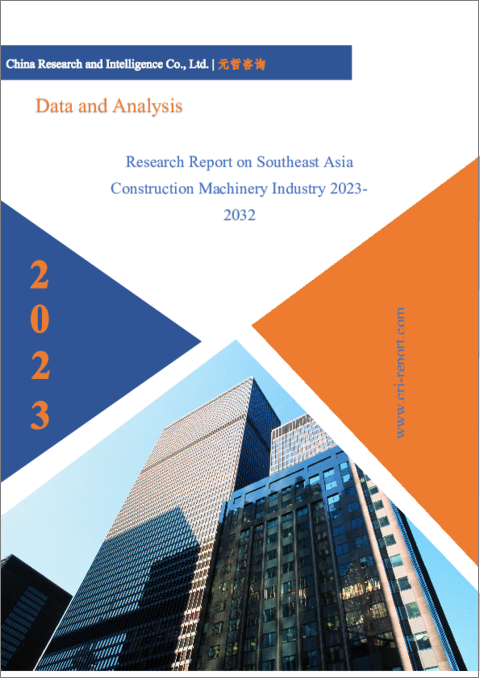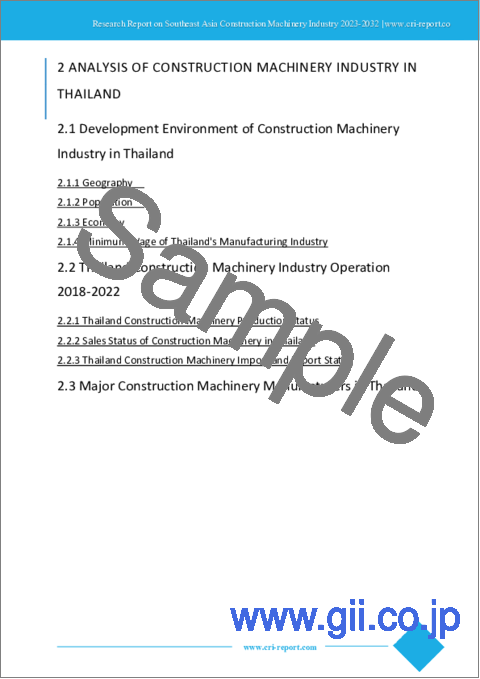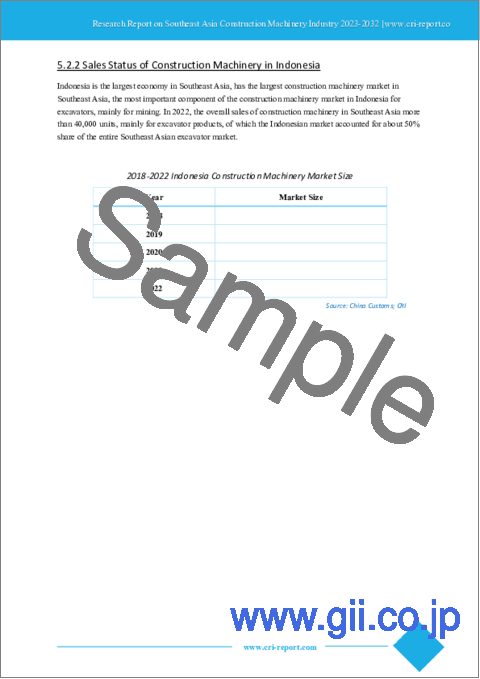|
|
市場調査レポート
商品コード
1174072
東南アジアの建設市場(2023年~2032年)Research Report on Southeast Asia Construction Industry 2023-2032 |
||||||
| 東南アジアの建設市場(2023年~2032年) |
|
出版日: 2022年12月16日
発行: China Research and Intelligence
ページ情報: 英文 80 Pages
納期: 即日から翌営業日
|
- 全表示
- 概要
- 目次
東南アジアの建設市場では、東南アジアの経済発展に伴い、インフラ建設や不動産分野が成長を続け、業界の発展に寄与しています。比較的安価な労働力と土地代に惹かれ、海外投資家が生産設備を東南アジアにシフトし、対外貿易が拡大し、工業用・商業用の不動産やインフラ部門の発展が建設業界を後押ししています。一方、東南アジアの経済成長に伴い、不動産業界も急成長しており、建設業界の発展を促進しています。
東南アジアの建設市場の発展状況は国によって大きく異なり、ベトナムやインドネシアでは急成長しています。一方、ミャンマーやカンボジアなどの国では比較的後進的です。
当レポートでは、東南アジアの建設市場について調査し、国別の市場分析、今後の見通しなどをまとめています。
目次
第1章 シンガポールの建設市場の分析
- マクロ環境
- 地理
- 人口
- 経済
- 製造業の最低賃金
- 市場概要(2018年~2022年)
- 供給
- 需要
- サブ業界の分析
- 主要建設会社の分析
第2章 タイの建設市場の分析
- マクロ環境
- 地理
- 人口
- 経済
- 製造業の最低賃金
- 市場概要(2018年~2022年)
- 供給
- 需要
- サブ業界の分析
- 主要建設会社の分析
第3章 フィリピンの建設市場の分析
- マクロ環境
- 地理
- 人口
- 経済
- 製造業の最低賃金
- 市場概要(2018年~2022年)
- 供給
- 需要
- サブ業界の分析
- 主要建設会社の分析
第4章 マレーシアの建設市場の分析
- マクロ環境
- 地理
- 人口
- 経済
- 製造業の最低賃金
- 市場概要(2018年~2022年)
- 供給
- 需要
- サブ業界の分析
- 主要建設会社の分析
第5章 インドネシアの建設市場の分析
- マクロ環境
- 地理
- 人口
- 経済
- 製造業の最低賃金
- 市場概要(2018年~2022年)
- 供給
- 需要
- サブ業界の分析
- 主要建設会社の分析
第6章 ベトナムの建設市場の分析
- マクロ環境
- 地理
- 人口
- 経済
- 製造業の最低賃金
- 市場概要(2018年~2022年)
- 供給
- 需要
- サブ業界の分析
- 主要建設会社の分析
第7章 ミャンマーの建設市場の分析
- マクロ環境
- 地理
- 人口
- 経済
- 製造業の最低賃金
- 市場概要(2018年~2022年)
- 供給
- 需要
- サブ業界の分析
- 主要建設会社の分析
第8章 ブルネイの建設市場の分析
- マクロ環境
- 地理
- 人口
- 経済
- 製造業の最低賃金
- 市場概要(2018年~2022年)
- 供給
- 需要
- サブ業界の分析
- 主要建設会社の分析
第9章 ラオスの建設市場の分析
- マクロ環境
- 地理
- 人口
- 経済
- 製造業の最低賃金
- 市場概要(2018年~2022年)
- 供給
- 需要
- サブ業界の分析
- 主要建設会社の分析
第10章 カンボジアの建設市場の分析
- マクロ環境
- 地理
- 人口
- 経済
- 製造業の最低賃金
- 市場概要(2018年~2022年)
- 供給
- 需要
- サブ業界の分析
- 主要建設会社の分析
第11章 東南アジアの建設市場の見通し(2023年~2032年)
- 市場発展に影響を与える要因の分析
- 有利な要因
- 不利な要因
- 市場発展の予測
- 市場における中国企業の配置
- COVID-19の流行が市場に与える影響
According to CRI's analysis, with the development of Southeast Asia's economy, the infrastructure construction and real estate sectors continue to grow, contributing to the growth of the construction industry.
The development of the construction industry in Southeast Asian countries varies greatly, such as Vietnam and Indonesia, where the construction industry is growing rapidly. While the construction industry in countries such as Myanmar and Cambodia are relatively backward.
Southeast Asia in this report includes 10 countries: Singapore, Thailand, Philippines, Malaysia, Indonesia, Vietnam, Myanmar, Brunei, Laos and Cambodia. With a total population of over 600 million by the end of 2021, Southeast Asia has an overall economic growth rate higher than the global average and is one of the key drivers of future global economic growth.
According to CRI's analysis, the economic levels of the 10 Southeast Asian countries vary greatly, with Singapore being the only developed country with a per capita GDP of about US$73,000 in 2021. While Myanmar and Cambodia will have a GDP per capita of less than US$2,000 in 2021. The population and minimum wage levels also vary greatly from country to country, with Brunei, which has the smallest population, having a total population of less than 500,000 people in 2021, and Indonesia, which has the largest population, having a population of about 275 million people in 2021. The most economically advanced countries in Southeast Asia do not have a legal minimum wage, with the actual minimum wage exceeding US$400 per month (for foreign maids), while the lowest minimum wage level in Myanmar is only about US$93 per month.
According to CRI forecast, the construction industry in Southeast Asia will continue to grow from 2023-2032. Relatively cheap labor and land costs have attracted a large number of foreign investors to shift production capacity to Southeast Asia, foreign trade has expanded, and the development of industrial real estate, commercial real estate and infrastructure sectors has boosted the construction industry. On the other hand, with the economic growth in Southeast Asia, the real estate industry is also growing rapidly, promoting the development of the construction industry.
Topics covered:
- Southeast Asia Construction Industry Status and Major Sources in 2018-2022
- What is the Impact of COVID-19 on Southeast Asia Construction Industry?
- Which Companies are the Major Players in Southeast Asia Construction Industry Market and What are their Competitive Benchmarks?
- Key Drivers and Market Opportunities in Southeast Asia Construction Industry
- What are the Key Drivers, Challenges, and Opportunities for Southeast Asia Construction Industry during 2023-2032?
- What is the Expected Revenue of Southeast Asia Construction Industry during 2023-2032?
- What are the Strategies Adopted by the Key Players in the Market to Increase Their Market Share in the Industry?
- What are the Competitive Advantages of the Major Players in Southeast Asia Construction Industry Market?
- Which Segment of Southeast Asia Construction Industry is Expected to Dominate the Market in 2032?
- What are the Major Adverse Factors Facing Southeast Asia Construction Industry?
Table of Contents
1 Analysis of Singapore's Construction Industry
- 1.1 Singapore Macro Environment
- 1.1.1 Geography
- 1.1.2 Population
- 1.1.3 Economy
- 1.1.4 Singapore Manufacturing Minimum Wage
- 1.2 Singapore Construction Industry Overview 2018-2022
- 1.2.1 Supply
- 1.2.2 Demand
- 1.2.3 Sub-Industry Analysis
- 1.3 Analysis of Major Construction Companies in Singapore
2 Analysis of the Construction Industry in Thailand
- 2.1 Thailand Macro Environment
- 2.1.1 Geography
- 2.1.2 Population
- 2.1.3 Economy
- 2.1.4 Thailand Manufacturing Minimum Wage
- 2.2 Thailand Construction Industry Overview 2018-2022
- 2.2.1 Supply
- 2.2.2 Demand
- 2.2.3 Sub-Industry Analysis
- 2.3 Analysis of Major Construction Companies in the Philippines
3 Analysis of the Philippine Construction Industry
- 3.1 Macro Environment of the Philippines
- 3.1.1 Geography
- 3.1.2 Population
- 3.1.3 Economy
- 3.1.4 Philippines Manufacturing Minimum Wage
- 3.2 Philippine Construction Industry Overview 2018-2022
- 3.2.1 Supply
- 3.2.2 Demand
- 3.2.3 Sub-Industry Analysis
- 3.3 Analysis of Major Construction Companies in the Philippines
4 Analysis of the Malaysian Construction Industry
- 4.1 Malaysia Macro Environment
- 4.1.1 Geography
- 4.1.2 Population
- 4.1.3 Economy
- 4.1.4 Malaysia Manufacturing Minimum Wage
- 4.2 Malaysia Construction Industry Overview 2018-2022
- 4.2.1 Supply
- 4.2.2 Demand
- 4.2.3 Sub-Industry Analysis
- 4.3 Analysis of Major Construction Companies in Malaysia
5 Indonesia Construction Industry Analysis
- 5.1 Indonesia Macro Environment
- 5.1.1 Geography
- 5.1.2 Population
- 5.1.3 Economy
- 5.1.4 Indonesia Manufacturing Minimum Wage
- 5.2 Indonesia Construction Industry Overview 2018-2022
- 5.2.1 Supply
- 5.2.2 Demand
- 5.2.3 Sub-Industry Analysis
- 5.3 Analysis of Major Construction Companies in Indonesia
6 Vietnam Construction Industry Analysis
- 6.1 Vietnam Macro Environment
- 6.1.1 Geography
- 6.1.2 Population
- 6.1.3 Economy
- 6.1.4 Vietnam Manufacturing Minimum Wage
- 6.2 Vietnam Construction Industry Overview 2018-2022
- 6.2.1 Supply
- 6.2.2 Demand
- 6.2.3 Sub-Industry Analysis
- 6.3 Analysis of Major Construction Companies in Vietnam
7 Analysis of Myanmar's Construction Industry
- 7.1 Myanmar Macro Environment
- 7.1.1 Geography
- 7.1.2 Population
- 7.1.3 Economy
- 7.1.4 Myanmar Manufacturing Minimum Wage
- 7.2 Myanmar Construction Industry Overview 2018-2022
- 7.2.1 Supply
- 7.2.2 Demand
- 7.2.3 Sub-Industry Analysis
- 7.3 Analysis of Major Construction Companies in Myanmar
8 Brunei Construction Industry Analysis
- 8.1 Brunei Macro Environment
- 8.1.1 Geography
- 8.1.2 Population
- 8.1.3 Economy
- 8.1.4 Brunei Manufacturing Minimum Wage
- 8.2 Brunei Construction Industry Overview 2018-2022
- 8.2.1 Supply
- 8.2.2 Demand
- 8.2.3 Sub-Industry Analysis
- 8.3 Brunei Major Construction Companies Analysis
9 Analysis of the Construction Industry in Laos
- 9.1 Laos Macro Environment
- 9.1.1 Geography
- 9.1.2 Population
- 9.1.3 Economy
- 9.1.4 Laos Manufacturing Minimum Wage
- 9.2 Laos Construction Industry Overview 2018-2022
- 9.2.1 Supply
- 9.2.2 Demand
- 9.2.3 Sub-Industry Analysis
- 9.3 Analysis of Major Construction Companies in Laos
10 Analysis of Cambodia's Construction Industry
- 10.1 Cambodia Macro Environment
- 10.1.1 Geography
- 10.1.2 Population
- 10.1.3 Economy
- 10.1.4 Cambodia Manufacturing Minimum Wage
- 10.2 Cambodia Construction Industry Overview 2018-2022
- 10.2.1 Supply
- 10.2.2 Demand
- 10.2.3 Sub-Industry Analysis
- 10.3 Analysis of Major Construction Companies in Cambodia
11 Southeast Asia Construction Industry Outlook 2023-2032
- 11.1 Analysis of Factors Influencing the Development of Southeast Asia Construction Industry
- 11.1.1 Favorable Factors
- 11.1.2 Unfavorable Factors
- 11.2 Southeast Asia Construction Industry Development Forecast 2023-2032
- 11.3 Layout of Chinese Companies in Southeast Asia Construction Industry
- 11.4 Impact of COVID -19 Epidemic on Construction Industry




